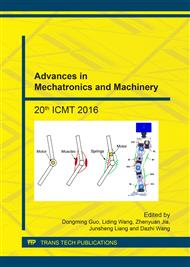[1]
K.C. Fan, Y.T. Fei, X.F. Yu, et al, Development of a low-cost micro-CMM for 3D micro and nano measurements, Measurement Science Technology, Vol. 17, No. 3, pp.524-532, (2006).
DOI: 10.1088/0957-0233/17/3/s12
Google Scholar
[2]
J. Zhu, R.G. Sun, Introduction to atomic force microscope and its manipulation, Life Science Instruments, Vol. 3, No. 1, pp.22-26, (2005).
Google Scholar
[3]
K.C. Fan, F. Cheng, W.L. Wang, Y.J. Chen, J.Y. Lin, A scanning contact probe for a micro-coordinate measuring machine (CMM), Measurement Science Technology, Vol. 21, No. 5, pp.603-616, (2010).
DOI: 10.1088/0957-0233/21/5/054002
Google Scholar
[4]
R. Furutani, K. Shimojima, K. Takamasu, Parameter calibration for non-cartesian CMM, Vdi Berichte, Vol. 18, No. 6, pp.317-326, (2004).
Google Scholar
[5]
E. Manske, G. Jager, T. Hausotte, R. Hausotte, Recent developments and challenges of nanopositioning and nanomeasuring technology, Measurement Science and Technology, Vol. 23, No. 7, pp.40-45, (2012).
DOI: 10.1088/0957-0233/23/7/074001
Google Scholar
[6]
Y.T. Fei, et al, Theory and application of mechanical thermal deformation, National Defence Industry Press, (2009).
Google Scholar
[7]
J. Feng, R.J. Li, Y.X. He, K.C. Fan, Development of a low-cost mini environment chamber for precision instruments, Proceedings of the Seventh International Symposium on Precision Mechanical Measurements, International Society for Optics and Photonics, (2016).
DOI: 10.1117/12.2211334
Google Scholar
[8]
J. Feng, R.J. Li, K.C. Fan, et al, Development of a low-cost and vibration-free constant-temperature chamber for precision measurement. Sensors and Materials, Vol. 27, No. 4, pp.329-340, (2015).
DOI: 10.18494/sam.2015.1131
Google Scholar
[9]
J. R. Thomas, J. P. Singh, Jr., D. P. H. Hasselman, Role of thermal stress resistance of semi-absorbing brittle materials subjected to sever thermal radiation. Springer US, (1982).
DOI: 10.1007/978-1-4684-8267-6_11
Google Scholar
[10]
Kramar J. A. Nanometre Resolution Metrology with the Molecular Mearsuring Machine. Measurement Science & Technology, Vol. 16, No. 11, pp.121-128, (2005).
Google Scholar
[11]
Y.T. Fei, Q.X. Huang, A new accurate calculation method of mechanical part thermal deformation in precision measurement, Proceeding of the Fourth International Symposium on Measurement Technology and Intelligent Instruments, (1998).
Google Scholar
[12]
Y.T. Fei, R.S. Lu, The science definition and application of linear thermal expansion coefficient of material, Journal of Applied Science, Vol. 14, No. 3, pp.253-258, (1996).
Google Scholar
[13]
Y.Y. Wang, F. Deng, J. Sun, Improved adaptive neural-network-based fuzzy inference system angular sensor error compensation method, Control Theory & Application, Vol. 30, No. 10, pp.98-103, (2013).
Google Scholar
[14]
R.J. Li, K.C. Fan, J.W. Miao, et al, An analogue contact probe using a compact 3D optical sensor for micro/nano coordinate measuring machines, Measurement Science & Technology, Vol. 25, No. 9, pp.1-33, (2014).
DOI: 10.1088/0957-0233/25/9/094008
Google Scholar
[15]
R.J. Li, K.C. Fan, Q.X. Huang, et al, A long-stroke 3D contact scanning probe for micro/nano coordinate measuring machine, Precision Engineering, Vol. 43, No. 4 pp.220-229, (2016).
DOI: 10.1016/j.precisioneng.2015.08.001
Google Scholar
[16]
R.J. Li, K.C. Fan, et al, Stability analysis of contact scanning probe for micro/nano coordinate measuring machine. Nano Technology & Precision Engineering, Vol. 10, No. 2, pp.125-131, (2012).
Google Scholar


